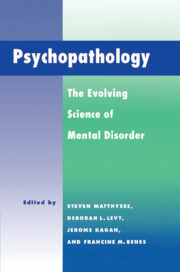Book contents
- Frontmatter
- Contents
- List of Contributors
- Preface
- Brain mechanisms
- Development
- Thinking
- Genetics
- 20 Editors' introduction: Contemporary issues in the genetics of psychopathological disorders
- 21 Genetic and environmental factors in the etiology of schizophrenia
- 22 Problems and paradoxes in research on the etiology of schizophrenia
- Comments on Einar Kringlen's chapter
- 23 Epistemological issues in psychiatric research
- 24 Searching for major genes for schizophrenia
- 25 The Drosophila eye and the genetics of schizophrenia
- Response and reflections
- Author index
- Subject index
24 - Searching for major genes for schizophrenia
Published online by Cambridge University Press: 04 May 2010
- Frontmatter
- Contents
- List of Contributors
- Preface
- Brain mechanisms
- Development
- Thinking
- Genetics
- 20 Editors' introduction: Contemporary issues in the genetics of psychopathological disorders
- 21 Genetic and environmental factors in the etiology of schizophrenia
- 22 Problems and paradoxes in research on the etiology of schizophrenia
- Comments on Einar Kringlen's chapter
- 23 Epistemological issues in psychiatric research
- 24 Searching for major genes for schizophrenia
- 25 The Drosophila eye and the genetics of schizophrenia
- Response and reflections
- Author index
- Subject index
Summary
Introduction
Few today would contest that genes are implicated in the etiology of schizophrenia, but general agreement ends at that broad conclusion. The extent of the genetic influence, the mode of genetic transmission, and the identification of specific etiologically relevant genes are still uncertain and are all areas of active research. Holzman and Matthysse (1990) have recently reviewed the genetics of schizophrenia with a perspective that reflects concerns that should be incorporated in research studies on schizophrenia. Others have also recently reviewed the genetics of schizophrenia (e.g., Diehl and Kendler, 1989; McGue and Gottesman, 1989; Gelernter and Kidd, 1990; Gottesman, 1991). Briefly, genetic studies have evolved from studies designed to show that genes are involved to studies designed to illuminate how genes and environment interact in the etiology of schizophrenia (see Figures 24.1 and 24.2). Unfortunately, the studies based on distribution of illness among relatives of schizophrenics, although giving results consistent with a substantial genetic component to etiology, have failed to provide definitive evidence of what the genetic factors are. As the diverse genetic hypotheses have become more sophisticated, it is either impossible to discriminate among them or any apparent discrimination is based on some assumption that, however plausible, remains unproven. For example, Risch (1990) concludes that genetic variation at a single locus cannot explain the recurrence risks observed in various classes of relatives.
- Type
- Chapter
- Information
- PsychopathologyThe Evolving Science of Mental Disorder, pp. 539 - 556Publisher: Cambridge University PressPrint publication year: 1996



